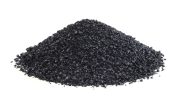The PFAS Solution: Calgon Carbon GAC
Calgon Carbon’s granular activated carbon (GAC) is the industry’s go-to solution for eliminating PFAS contaminants for water and wastewater treatment. Once the carbon has been fully spent, it undergoes a reactivation process in which the carbon’s adsorbed contaminants are volatilized and destroyed at high temperatures with >99.99% efficacy. This process allows the GAC to return to a near-virgin state and is functional for reuse and is functional for reuse, which has been verified by third-party testing and review. For more info on their findings, find their report here.
The Process of GAC Reactivation
- Spent GAC is placed into multiple hearth furnaces or rotary kilns with a high-temperature steam reaction to develop its pore volume and restore its adsorptive capacity.
- Adsorbed organics are then volatilized or pyrolyzed to a carbon char. The GAC is now reactivated for reuse.
- Reactivated furnaces are maintained under negative pressure to treat emissions produced to ensure that no leaks reach the outside environment.
- The furnace off-gas passes through an afterburner or thermal oxidizer for additional destruction of any chemical constituents remaining from the reactivation process.
- The emission stream then passes through a chemical scrubber to remove acid gases and any remaining particulate matter is removed through baghouse filter treatments.
Advantages
- Activated carbon offers a unique advantage over other treatment media as it can be recycled and reused through reactivation.
- Aids in achieving sustainable media processing while also significantly reducing CO2 emissions, minimizing long-term liability, and lowering total cost of ownership.
Products and Applications
FILTRASORB® 300 & 400
FILTRASORB® 300 and 400 activated carbon possess versatile capabilities in removing dissolved organic compounds across various liquid phase applications. Their efficacy has been proven over four decades of successful application, including but not limited to, the purification of drinking and process water, wastewater treatment, and industrial, food, and pharmaceutical purification processes.
FILTRASORB® 816 & 820
The primary application of FILTRASORB® 820 and 816 is the treatment of surface water sources intended for use as drinking water. Due to its coarser mesh structure, this carbon-based media is typically utilized in deep bed filters where pressure drop is a potential concern. FILTRASORB 820 serves a dual function as both a filtration and adsorption media, enabling it to effectively remove impurities from the water source.

Learn more about our FILTRASORB® products
More About PFAS: The Toxic Intruder Lurking in Your Water Supply

Per- and polyfluorinated compounds are a group of man-made chemicals that have been widely used in various industrial and consumer applications for decades. They are highly persistent in the environment and can accumulate in the human body over time, which has raised concerns about their potential health effects. Perfluorooctane sulfonate (PFOS) and Perfluorooctanoic acid (PFOA) are the most mentioned forms of PFAS, but PFAS is a class of over 6,000 compounds. They are found in firefighting foams, non-stick cookware, stain-resistant and water-resistant fabrics, and food packaging. During past manufacturing processes, large amounts of PFAS have been produced and released into the air, soil, and water.
- Exposure to PFAS has been shown to increase cholesterol levels in humans, which can increase the risk of heart disease.
- PFAS can affect the immune system, making it more difficult for the body to fight off infections and diseases.
- PFAS can interfere with the body’s hormone system, potentially leading to reproductive developmental problems.
- They are extremely difficult to remove due to their resistance to direct oxidation, photolytic degradation, biodegradation, and air stripping/vapor extraction techniques.
- In 2021, the Canadian government announced a ban on the import, manufacture, and use of firefighting foam containing PFAS, with some exceptions for military and aviation uses.
- The government has also established a drinking water guideline for PFAS of 1 nanogram per litre (ng/L) for PFOA and PFOS, two common PFAS compounds, as well as a health-based guidance value of 7 ng/L for other PFAS.
- As of March 2023, the EPA has released new draft enforceable Maximum Contaminant Levels (MCL) for PFOA and PFOS permissible in drinking water at a national level in the US. The new allowable levels are 4ppt for PFOA and 4ppt for PFOS
The Problem
- With more than 6,000 substances, PFAS will remain in the environment for a very long time in areas such as waterways, air, landfills, and soils.
- Health Canada sampled a small portion of those areas and discovered that PFAS can be found in 99% of Canadians.
- A three-part study on PFAS in Canada was created by CBC in October and November 2020. It included the first map of PFAS hotspots and surface water contamination in Canada, based on the information available at the time.
- Data gathered by the US Environmental Protection Agency and made public on October 17, 2021 depicted more than 120,000 locations across the country where people may be exposed to PFAS—four times as many as was previously thought. There is no comparable data despite identical facilities in Canada.

Our Solution
Our commitment to addressing PFAS contamination is evident through the comprehensive range of innovative treatment solutions we have developed. By prioritizing research and development, we aim to not only remediate existing contamination but also contribute to a broader understanding of PFAS management. Encouraging widespread awareness and education is integral to our mission, and we invite individuals to explore the various treatment methods we offer, fostering a collective effort towards a sustainable and PFAS-free future. Through continuous learning and collaboration, we aspire to pave the way for effective solutions and promote a heightened consciousness of the importance of addressing PFAS-related challenges in our communities.

